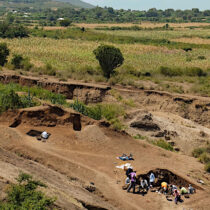Someone born near the start of the 20th century could have witnessed the dawn of commercial flight, the creation of nuclear weapons, the moon landing and even the early growth of the internet. Technology did not always progress so fast, however, especially not for hominins, our distant human ancestors. In fact, despite major environmental change, a tool technology roughly equivalent to a Swiss army knife was associated with hominin occupation for more than 300 thousand years.
New findings out of Kenya by an international team of researchers, including Amelia Villaseñor, an associate professor of anthropology at the University of Arkansas, reveal profound consistency in the use of stone tool technology over time. Stone tools recovered from three distinct layers of the Turkana Basin, representing three time periods, show a tradition of continuous tool use spanning roughly 300,000 years, from 2.75 to 2.44 million years ago. This dates the tools to close to the beginnings of Oldowan technology, the earliest widespread stone-tool tradition made by striking flakes off a stone core to create sharp cutting edges.
The tools were recovered from a site on the northeast side of Lake Turkana called Namorotukunan, which preserves three discrete layers dated to about 2.75, 2.60, and 2.44 million years ago. These layers each preserve different snapshots of environmental conditions from humid floodplains to arid riverine settings. This is the earliest Oldowan record yet reported from the Koobi Fora Formation and among the oldest worldwide.
David R. Braun, at professor of anthropology at George Washington University and the Max Planck Institute, who led the study, said the site “reveals an extraordinary story of cultural continuity.”
Villaseñor describes herself as a paleoecologist. She studies paleoenvironments by looking at non-hominin fossils, such as animals or plants, to gain insight into the environments in which fossils lived. For this study, Villaseñor analyzed pedogenic carbonates. These small nodules provide signals from& ancient plant roots found in the soil from which stable isotope signals can be identified.
“Put simply, these signals tell us whether there were grasses or whether there were trees,” she explained.
More importantly, this research can also tell us whether the environment changed over time. In fact, field and lab work from Villaseñor and her colleagues confirmed that hominin tool use weathered major climate swings over the 300,000-year period of the study. Plant microfossils, plant chemistry and traces of natural fires, along with chemical and magnetic properties of the ancient river muds and sands, show habitats shifted from palm-dotted wetlands to drier, open grasslands and semideserts, yet the toolmaking persisted.
“I try to relate changes in the environment to changes in behavior,”Villaseñor said. “In Ethiopia, the oldest stone tools were recovered during an arid period. The fact that these early stone tools in Kenya are found in sites that preserve everything from micro charcoals — potentially representing& fire — to droughts, and other signs of aridity is fascinating. It connects tool use and environmental change across eastern Africa in a really interesting way. Hominins likely utilized stone tools to access new resources to survive.”
The study shows that toolmakers preferred a raw material called chalcedony, a rare and tough, fine-grained stone, pointing to deliberate material choice and practiced skill. Cut-marked bones, especially those dated to around 2.58 million years ago, link the flaked stones directly to butchery, marking an early shift toward animal foods.
“Namorotukunan offers a rare lens on a changing world long gone — rivers on the move, fires tearing through, aridity closing in — and the tools, unwavering,” said Dan V. Palcu Rolier, a geoscientist with the University of São Paulo and GeoEcoMar who was a co-author on the paper. “For approximately 300,000 years, the same craft endures — a declaration of independence that may mark when technology first put our ancestors at the helm of their evolution.
As the landscape dried, rivers may have become predictable lifelines, providing water, raw materials and feeding opportunities. Early hominins kept returning to these ancient rivers, accessed food using Oldowan technology, and left behind the more than 1,200 artifacts found today.
Ultimately, Namorotukunan reveals an enduring tradition, not a moment: human ancestors made the same types of tools for hundreds of thousands of years.
“This study, linking a simple tool kit to human ingenuity, reminds us that our ancestors have successfully confronted and survived environmental challenges,” Villaseñor suggested. “We can survive whatever the future throws at us; we may just need to look into the ancient past.”





